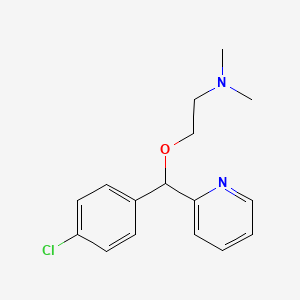CASRN: 486-16-8

Drug Levels and Effects
Summary of Use during Lactation
Small occasional doses of carbinoxamine are probably acceptable during breastfeeding. Larger doses or more prolonged use may cause drowsiness and other effects in the infant or decrease the milk supply, particularly in combination with a sympathomimetic such as pseudoephedrine or before lactation is well established. The manufacturer recommends avoiding breastfeeding during carbinoxamine use because severe toxicity has occurred in children under 2 years. The nonsedating antihistamines are preferred alternatives.
Drug Levels
Maternal Levels. Relevant published information was not found as of the revision date.
Infant Levels. Relevant published information was not found as of the revision date.
Effects in Breastfed Infants
There are no reports of infants breastfed during maternal therapy with carbinoxamine. In one telephone follow-up study, mothers reported irritability and colicky symptoms in 10% of infants exposed to various antihistamines and drowsiness was reported in 1.6% of infants. None of the reactions required medical attention.[1]
Effects on Lactation and Breastmilk
Antihistamines in relatively high doses given by injection can decrease basal serum prolactin in nonlactating women and in early postpartum women.[2,3] However, suckling-induced prolactin secretion is not affected by antihistamine pretreatment of postpartum mothers.[2] Whether lower oral doses of carbinoxamine have the same effect on serum prolactin or whether the effects on prolactin have any consequences on breastfeeding success have not been studied. The prolactin level in a mother with established lactation may not affect her ability to breastfeed.
Alternate Drugs to Consider
References
- 1.
- Ito S, Blajchman A, Stephenson M, et al. Prospective follow-up of adverse reactions in breast-fed infants exposed to maternal medication. Am J Obstet Gynecol. 1993;168:1393–9. [PubMed: 8498418]
- 2.
- Messinis IE, Souvatzoglou A, Fais N, et al. Histamine H1 receptor participation in the control of prolactin secretion in postpartum. J Endocrinol Invest. 1985;8:143–6. [PubMed: 3928731]
- 3.
- Pontiroli AE, De Castro e Silva E, Mazzoleni F, et al. The effect of histamine and H1 and H2 receptors on prolactin and luteinizing hormone release in humans: Sex differences and the role of stress. J Clin Endocrinol Metab. 1981;52:924–8. [PubMed: 7228996]
Substance Identification
Substance Name
Carbinoxamine
CAS Registry Number
486-16-8
Drug Class
Breast Feeding
Lactation
Antihistamines
Disclaimer: Information presented in this database is not meant as a substitute for professional judgment. You should consult your healthcare provider for breastfeeding advice related to your particular situation. The U.S. government does not warrant or assume any liability or responsibility for the accuracy or completeness of the information on this Site.
Publication Details
Publication History
Last Revision: September 20, 2021.
Copyright
Attribution Statement: LactMed is a registered trademark of the U.S. Department of Health and Human Services.
Publisher
National Institute of Child Health and Human Development, Bethesda (MD)
NLM Citation
Drugs and Lactation Database (LactMed®) [Internet]. Bethesda (MD): National Institute of Child Health and Human Development; 2006-. Carbinoxamine. [Updated 2021 Sep 20].